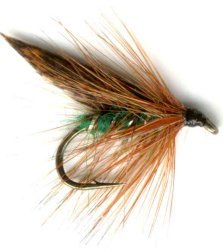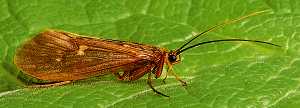Green Peter Caddis (Sedge) Wet Fly
The traditional Green Peter wet fly is a drowned Irish phryganea varia caddis fly imitation which is mainly used on large still waters like Irish loughs, Scottish Highland Lochs, reservoirs and lakes for trout and grayling.

CADDIS WET FLY PATTERNS. Hook size 10 12 14 - $US each
The Green Peter Caddis wet fly pattern was originally created as a fly to be used as a top dropper. It gives good results on rivers and streams following a hatch of caddis. Not all emerging caddis manage to survive the change into adulthood. They get stuck in their old pupa casing and drown. This is easy pickings for lurking wild brown trout. When there is a caddis hatch happening the fish are switched on to look for subsurface winged insects in trouble and this is what the Green Peter fishing fly tries to imitate. It can be treated with floatant and surface fished through the waves as part of a team of flies but there are better, more buoyant caddis flies for that roll available like the Goddard's Caddis, tent winged Caddis and Elk Hair Caddis fly patterns. The Green Peter is a wet fly and works best under the waves in my experience.
The common or slang term ‘sedge’ originates from the fact that adult Caddis flies can often be found clinging to sedge grass near the waters. Sedge/Caddis flies have four wings. The forward pair are normally a little longer than those at the rear. At rest their wings lie close along the body in an inverted V shape. Caddis flies do not have tails but many have long antenna. The Latin name for this group of flies is ‘Trichoptera’ (Greek for 'hairwing'). They pass through four stages in their development; egg, larva, pupa and adult. The eggs are laid by the adult female in large jelly mass, which often floats on the water surface and drift until they stick to some river side vegetation. Some species lay their eggs directly on vegetation. The eggs hatch into larva in about 10-12 days. The Larvae produce a sticky substance and attach what ever material in on the river bed to their body. This offers protection and camouflage. The pupa stage lasts for several days. The fully formed pupa has middle body legs that it uses to swim to the surface to hatch. Some species choose the shore or vegetation to emerge rather than open water where they are easy prey for the trout

Adult caddis flies vary in size. Their bodies are rather drab in color from gray, brown to green. The wings are mottled, patterned or pale and vary in colour from black, brown to gray. If the fish are not taking fly patterns of natural colors try a brightly colored attractor pattern of the correct shape. Most hatch early or late evening. Some hatch in the afternoon and some at night. The fish have two chances of catching these flies; when they emerge and when they return to lay eggs. Some species have a problem drying their wings and remain on the surface for a considerable time, causing a disturbance. Others that move to shore to hatch fully also cause a disturbance.
A wet fly is designed to be fished below the water's surface. They are tied as deceivers or attractors. The success of the wet fly often depends far more on its action in the water than on its resemblance to a particular insect, but this is not always the case. When fish are on the feed the actual pattern is generally not important, but when the fish are preoccupied or need tempting the angler must use ingenuity to discover what the fish are feeding on and what color they are taking. When fishing wet flies, it is important to remember that the higher the wave on the water the higher the fly hook size can be, but still take into account the brightness and clarity of the water.
Trout do see subsurface insects with wings. Some flies begin to hatch below the water surface. The Baetis group of up-winged flies swim or crawl beneath the surface as adult spinners in order to lay egg. There are occasions when duns and spent spinners are swamped by the current and forced under the water surface. Emerging duns that have been unable to get rid of their nymphal case or at the time of emerging are drowned when they float under rough water that is flowing over a large rock or ledge are also hunted by the fish. The trout on purpose lurk in slack water near eddies and small plunge pools to look out for these type of snacks. Clearly a trout does see winged insects under the surface at certain times of the year so be prepared with a selection of different colored wet flies for when the fish are not taking from the surface.
GREEN PETER AND THE ISLE OF SKYE
There are a number of hill lochs on the Isle of Skye. Though not great in number they offer the chance of the occasional big fish in startling rugged powerful looking landscape. Loch Cuithir, with the great broken rock face of Sgurr a Mhadaidh Ruaidh standing tall over its southern end is a good example. Though tiny, the loch holds remarkably large trout for such a northerly cold location. Getting them out is another matter.
I found the fly that did the trick was the Green Peter caddis wet fly fished on the middle dropper of a team of three flies. I believe the fish took it as a drowned caddis. I managed to catch six brown trout all on the Green Peter apart from the second fish of the day which took my beaded pheasant tail nymph on point. The last fish of the day took my fly with a thrashing swirl, that almost pulled the rod from my hand.
CUSTOMER'S COMMENT
I took a cheap, Ryanair weekend flight to Ireland and made my way by hire car to the west of Galway. Just off the coast of Galway Bay, there is an island called Gorumna. In the centre is an old glacial lake named Loch Hibbert. It is a fishery that is reputed to produce bigger than average trout. You can hire out boats and Gillies. The locals advice is very important if you want to have a productive day. They know where the fish lie. The top flies for Loch Hibbert are Irish Classics like the Green Peter, Mallard and claret, and a daddy longlegs in August. I caught three good sized trout on your Green Peter wet fly pattern. Thanks tight lines Peter Browne, Bedfordshire.


Fly Fishing books

